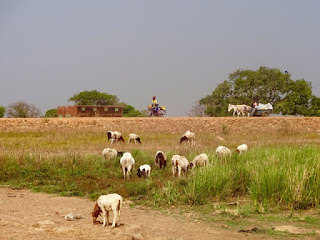I awoke in Pô rested and ready for my reason for being there: to visit Tiébélé. I went out for breakfast: Nescafe, yogurt, and bread, which cost about a dollar. I then met my driver at the hotel, a young guy named Patrice, who spoke no English and wore a knitted scarf in the 40 degree heat. He had a motorbike (and as usual helmets are not available) and we set off. We bounced down the dry and dusty orange streets headed south to Tiébélé past donkey carts, kids headed to school, and women washing clothes with washboards and buckets.
After about 15 minutes we spotted one of the common police checkpoints. Patrice said (in French) "Policeman. It is a problem for me." And we turned around to take a detour. This is one of those times when my rudimentary French was not enough to clarify the situation. Why were the police a problem? Did he not have ID? Was the moto not registered? Was he wanted for murder? I would never know and simply said "ok".
Our detour was pleasant, past little villages and large baobab trees, many of which were hung with ropes of sorgum to dry.
We stopped at a little lake and looked at the fields of potatoes, tomatoes, and peppers growing in tidy green rows.
After an hour maybe we arrived in the town of Tiébélé, which is small but had a few shops and cafes. There was a small hut with art and the painter showed me his work, which included pictures of Tiébélé, Che Guevara, and Thomas Sankara.
Patrice and i stopped and had a drink with his brother, who spoke a bit of English, and the the three of us headed to the old village.
Patrice's brother gave me a tour of the village, which is known for its painted huts, which are covered in symbolic designs representing animist tradition. Geometric patterns, lizards, tortoises, and seeds were common.
The village was designed for protection from enemies and is laid out in a windy maze, with tiny doorways into the houses to thwart invaders. I learned that round huts were for single people, square huts for married couples, and huts shaped like figure eights were for seniors. I was shown (but not allowed to photograph) the place where sacrifices are made for the village.
I got to go into one hut, which had three rooms, including a kitchen, each separated with tiny portals which one had to crawl through. People live there today and were all quite friendly, particularly the children who handed me peanuts while saying bonjour.
It was all very interesting and worth the journey to get there from Ouagadougou.
After the village, we had coffee and took a stroll through the market, where i bought some oranges.
We returned to Pô and i killed time until my bus back to Ouagadougou. I watched some tv with the proprietor of my hotel and had a cigar while making some small talk in Franglais.
The bus ride back was mostly in the dark and was a bit nerve-wracking, as the highway was completely dark and the landscape disappeared. The security checkpoints seemed more ominous and for a while machine gun armed soldiers in full combat gear rode with us through an area known for attacks from bandits.
After about three hours we arrived in Ouagadougou and i made my way back to my hotel, where i fell asleep, too tired for dinner. A long but good day.










1 comment:
This the type of village i would have liked to see.
Post a Comment